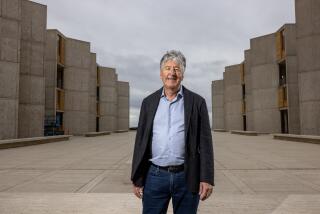Salk Researchers Report Brain Cell Breakthrough
- Share via
SAN DIEGO — A team led by a Salk Institute researcher has developed a way to genetically engineer brain cells that grow indefinitely in the laboratory, giving scientists the possibility of cultivating colonies of specialized neurons to study in ways never before possible.
“This gives us a tool to investigate interactions between (brain) neurons in isolated and controlled conditions,” said Pamela Mellon, a Salk associate professor who led the research. “In the case of our own work on how the brain controls reproduction, it might offer a way to understand conditions like late puberty, PMS (premenstrual syndrome) or infertility.”
The technique might also provide a way to grow neurons that produce other critical brain secretions, such a dopamine, which is deficient in victims of Parkinson’s disease.
Mellon and her colleagues reported in Friday’s issue of the journal Neuron that they linked a cancer-causing gene, called an oncogene, to another gene, called a “promoter,” and inserted the combination into a fertilized mouse egg. The added genes were integrated into every cell in the mouse’s bodies.
The oncogene was not able to cause a tumor unless it was “turned on” by the promoter. And the promoter would not turn on the oncogene until it itself was exposed to a certain hormone, which is present only in a specific area of the brain, the hypothalamus.
The net result was that mice developed tumors of the hypothalamus. Mellon isolated cancer cells from the tumor and found that they would grow and proliferate in the laboratory.
From each cell in the tumor, they could grow identical progeny of the cells, called clones. Mellon is interested in the molecular basis of the reproductive hormone system, so such clonal groups of hormone-producing cells are ideal for study.
“Some of the real advantages are that you can study the hormone production system without influences of all the other kinds of cells in the brain and without all the chemicals that are present in the blood of an animal,” Mellon said. This should enable researchers to study some diseases of the brain in tissue culture.
Dr. Solomon Snyder, a prominent Johns Hopkins University brain researcher, suggested Friday that this could be a useful way to replace hormone-secreting cells in the brain for treatment of a number of diseases, including Parkinson’s. But he said it would be much more difficult to use it to replace cells involved in thought processes.
“Whether it would work for neurons in the brain (outside the hypothalamus) . . . we of course don’t know because they are different.”
Snyder noted that the Nobel Prize-winning work showing these hormone systems’ origin in the hypothalamus was done at Salk, by Roger Guillemin, who is now at the Whitter Institute at Scripps Memorial Hospital in La Jolla.
Mellon confirmed that, for further research, her group is working first with hypothalamic neurons.
“I think cortical neurons are going to be difficult, but at some point in early development they do divide, and, if we can find the gene that turns on just when they’re just turning into that type of cell, I think we can get them,” she said.
Other scientists who worked with Mellon were Jolene J. Windle, who recently left Salk for the Cancer Therapy and Research Center in San Antonio, Tex.; Paul C. Goldsmith, Cheryl A. Padula and Richard I. Weiner of UC San Francisco; and James L. Roberts of Mt. Sinai School of Medicine in New York City.
The Salk research was the second major development within the last three months in the neuron-culturing field, which previously was at a stalemate. The first, announced in May, was achieved by a Johns Hopkins group that included Snyder and Gabriele Ronnett.
They removed non-cancerous but abnormally proliferative brain cells from the brain of an 11-month-old girl and succeeded in culturing them indefinitely in the lab.
Researchers at Hana Biologics in Berkeley have also been growing brain cells in culture in hopes of using them to treat Parkinson’s Disease, but have not published results of their work.
Times science writer Thomas H. Maugh II contributed to this story.






